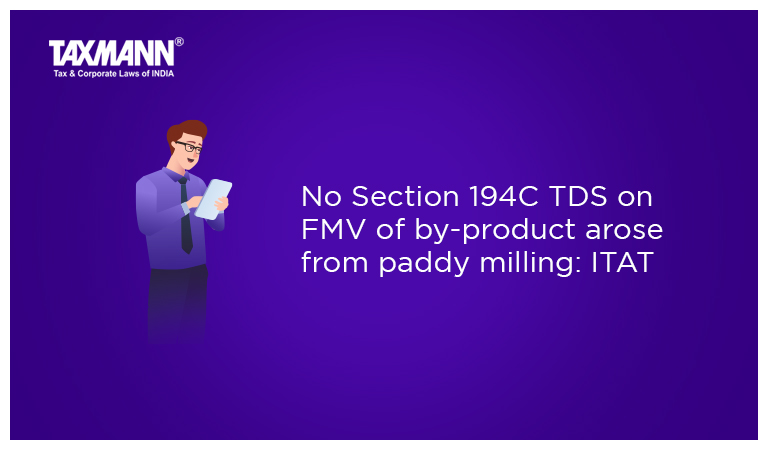No Section 194C TDS on FMV of by-product arose from paddy milling: ITAT
- Blog|News|Income Tax|
- 2 Min Read
- By Taxmann
- |
- Last Updated on 3 August, 2022
Case Details: Assistant Commissioner of Income-tax (TDS) v Punjab State Civil Supply Corporation Ltd. - [2022] 140 taxmann.com 507 (Chandigarh-Trib.)
Judiciary and Counsel Details
-
- Smt. Diva Singh, Judicial Member & Vikram Singh Yadav, Accountant Member
- Sarabjeet Singh, CIT DR for the Appellant.
- Vibhor Garg, CA for the Respondent.
Facts of the Case
Assessee was a procurement agency of the Government that was engaged in procuring paddy, getting it milled, and supplying rice to the Government.
During the year, the assessee entered into agreements with millers for milling paddy for consideration of a certain amount as milling charges fixed by the Government. Assessee deducted TDS under section 194C on said charges paid to the miller.
However, the Assessing Officer (AO) noted that by-products arose from milling to the tune of 33 percent of paddy milled being retained by the miller free of cost. AO held that it constituted consideration in kind paid by the assessee to miller whereon no TDS was being deducted by the assessee. Thus, he held the assessee as assessee-in-default.
On appeal, the Commissioner (Appeals) held that the assessee was not liable to deduct tax under section 194C in respect of the value of the by-products. Aggrieved revenue filed the instant appeal before the Tribunal.
ITAT Held
The Tribunal held that the by-product is agreed to be kept with the miller as per the policy of the Government and there is no option to the miller even to say that it will not retain the by-product or to demand any sum more than the fixed rate on account of milling.
As per the agreement, the procurement agency/assessee never becomes the owner of the by-product. At the very point of coming into existence of the by-product, the same remains the property of the miller.
Thus, when as per the terms of the agreement, the by-product is never involved to be the property of the procurement agencies, it cannot be said that the said by-product was handed over as consideration in kind by the procurement agencies to the millers.
Accordingly, since it was established that property in by-product was not passed by the assessee as milling charges, no TDS under section 194C was to be deducted on said by-product kept by miller.
List of Cases Referred to
-
- D.M. Punjab Civil Supply Corpn. Ltd. v. ITO [IT Appeal No. 158 (Asr.) of 2016, dated 4-8-2016] (para 2)
- ITO, TDS v. Distt. Manager, Punjab State Warehousing Corpn. [2018] 100 taxmann.com 28 (Chd. – Trib.) (para 2).
Disclaimer: The content/information published on the website is only for general information of the user and shall not be construed as legal advice. While the Taxmann has exercised reasonable efforts to ensure the veracity of information/content published, Taxmann shall be under no liability in any manner whatsoever for incorrect information, if any.

Taxmann Publications has a dedicated in-house Research & Editorial Team. This team consists of a team of Chartered Accountants, Company Secretaries, and Lawyers. This team works under the guidance and supervision of editor-in-chief Mr Rakesh Bhargava.
The Research and Editorial Team is responsible for developing reliable and accurate content for the readers. The team follows the six-sigma approach to achieve the benchmark of zero error in its publications and research platforms. The team ensures that the following publication guidelines are thoroughly followed while developing the content:
- The statutory material is obtained only from the authorized and reliable sources
- All the latest developments in the judicial and legislative fields are covered
- Prepare the analytical write-ups on current, controversial, and important issues to help the readers to understand the concept and its implications
- Every content published by Taxmann is complete, accurate and lucid
- All evidence-based statements are supported with proper reference to Section, Circular No., Notification No. or citations
- The golden rules of grammar, style and consistency are thoroughly followed
- Font and size that’s easy to read and remain consistent across all imprint and digital publications are applied








 CA | CS | CMA
CA | CS | CMA


